Данная статья является реферативным изложением основной работы. Полный текст научной работы, приложения, иллюстрации и иные дополнительные материалы доступны на сайте VII Международного конкурса научно-исследовательских и творческих работ учащихся «Старт в науке» по ссылке: https://school-science.ru/7/3/40290/.
Theme. Studying of modification of ancient roots in the European languages. The investigation of the logic and history of language development by means of Corpus Linguistics.
Relevance of the project. The project draws attention to the value and uniqueness of native language and highlights the importance of intercultural relations. It allows to see the current trends of the language development for the needs of computational linguistics. It draws attention to the possibilities of Corpus Linguistics and it is relevant from the educational point of view.
The hypothesis. The evolution of ancient roots reflects the main trends and laws of language development.
The aim of the project. I would like to compare the use of ancient roots in different European languages. My aim was to study in practice the patterns of their modification in languages of different structure and to investigate the reflection of the words’ history in their semantics.
Tasks of the project:
1. To identify and explore words with several Latin, Ancient Greek and Indo-European roots in the vocabulary of modern European languages of different level of affinity.
2. To compare the imprints of these roots in related languages of different grammatical and morphological structure.
3. To study in practice the differentiation by meanings of words with such roots and to carry out a comparative analysis.
4. To demonstrate language trends with the help of Corpora of Russian, English and other languages, to summarize the material.
Methods. I used the following methods: the analysis and summing up of information, the use of language Corpora for the linguistic investigation, studying of everyday vocabulary of Slavic languages (Russian, Slovenian, Czech) during the trip, conducting interviews of native speakers, comparative analysis of the results, summing up data in tables, making general conclusions to prove or to refute the hypothesis.
I applied methods of Corpus Linguistics and employed the material of Russian National Corpus [13] and British National Corpus [15] in my investigation (May 2018 – November 2018, Moscow). I also used Sketch Engine in my work (June 2018 – July 2018, Moscow). It is a special tool to explore how languages work [14]. Its algorithms analyze text corpora and identify instantly what is typical in language and what is rare. An example of some sheets from my Laboratory register is shown in Appendix 10. I also conducted a survey of native speakers during my journey (July 2018 – August 2018, Slovenia).
Information on the history and classification of languages was studied with the help of special literature and e-resources and systematized in the Theoretical part. Scientific approach based on the history and sound correspondences of languages is very important in the investigation of the origin of words and the affinity of languages. Random consonance can’t become a reason for conclusions about the relationship of languages [6].
The main part
1. Theoretical part
1.1. Indo-European family of languages and the ancient languages in its basis
Indo-European language family is the largest among the linguistic families of Eurasia. Linguists have defined by new comparative methods the relationship of the most European languages with many languages of India, in particular ancient Sanskrit and modern Hindi [6]. The single Indo-European proto-language broke up into many languages-descendants, spread by the movement of peoples [5] (Appendix 1).
Languages have an interesting feature: words are almost never invented; each language always goes by the way of continuity, which makes it stable [6]. Grammars of languages change, but the roots of words live much longer, moving from one language to another.
Each of Ancient languages had a huge impact on the development of civilization and gave new living «sprouts», which became the languages of the new time. Social, economic and cultural contacts of different nations lead to borrowing words from other languages. They encourage the development of vocabulary and give a new life to ancient roots [8].
1.2. Ancient roots in different languages of modern Europe
The same roots can be found in a variety of European languages, not always closely related. It is shown the table of Lexical and phonetic correspondences in different Indo-European languages [6], presented in Appendix 2. The table in Appendix 3 contains some interesting examples of the same Indo-European roots in different languages.
The role of languages of great Ancient civilizations in the development of mankind is invaluable. For example, we can hear international words and individual Greek-Latin morphemes: roots, prefixes and suffixes, in all European languages. [4, 11]. I have compiled a table of international «elements» of ancient languages widely used to construct words (Appendix 4).
Three layers of Latin borrowings are distinguished in English [1], [9]. I was interesting for me to analyze what groups of words were borrowed in different epochs and why. A table with examples is shown in Appendix 5.
It is important to mention that the first Russian grammar, created in 1755 by M.V. Lomonosov, took into account the grammar of Ancient Greek and Latin [5]. Furthermore, many well-known words created M. V. Lomonosov are replications of Latin words: кислород, наблюдение, явление, предмет, опыт, движение, водород [8]. And the idea of creating compound words with two roots was borrowed from Ancient Greek [7]. While studying the material about Latin and Greek roots in the words created by M. V. Lomonosov, I have also collected information about the words that had been created by this great scientist, but then rejected by himself or pushed out by other people (Appendix 6).
1.3. Borrowings and their role in the enrichment of languages
There are different ways of borrowing: transliteration (letter by letter), transcription (by the sounds), replication (copying of the structure of words) and borrowing «by ear» [2]. The way of borrowing and its epoch deeply influence the formation of words in the language. I have analyzed the influence of different ways of borrowings on the vocabulary. A few examples of loanwords from different ways and epochs of borrowing are shown in the table in Appendix 7.
A particularly interesting effect takes place when words with similar meanings are borrowed. The differences in nuances make the language richer and more figurative [1]. In the Russian language borrowings of ancient roots from the Church Slavonic language have played a unique role [4, 15]. They have enriched and enabled Russian to become so beautiful, or example: город – град, берег – брег, житье – житие, обнять – объять, одёжа – одежда. Thus, the same ancient root can give several «descendants» in one language. They differ phonetically, semantically and lexically.
The study of ancient roots reveals many secrets. I have picked up some interesting word stories [8, 7, 13] (Appendix 8).
1.4. The influence of language structure on its development
Language structures influence the modification of ancient roots. Languages are grammatically divided into analytical and synthetic. In analytic languages the grammar uses the word order and service words, not morphemes (endings, suffixes) of a word. In synthetic languages morphemes within words can be combined on the principle of agglutination or fusion [6]. Agglutination is the «bonding» of the morphemes in the word, when they remain unchanged and visible. Fusion is a method of connecting morphemes, in which they often change on the border, their seam is barely noticeable.
I have analyzed the features of each system [6, 5, 7, 2] and compiled the results (Appendix 9). The same root in different languages behaves in different ways according to their grammar.
Furthermore, each language is improving, its system is changing. The movement of the English language towards analyticity can serve an example [1]. It can be seen that old English words had more flections, while nowadays the same idea is expressed with a few words, which shows the movement towards analyticity [9].
Understanding the modern linguistic picture of the world and its changes in the future is impossible without studying the ancient roots, which like strings stretch from the depths of history and continue to live and develop.
2. Practical part
2.1. The study of ancient roots in languages of different level of affinity
2.1.1. Differences in the words from one ancient root in different languages
Similar words of one ancient root may vary in different languages. These differences may increase over time. With the help of Sketch Engine [14] I have analyzed words from the same Latin root in different languages. Semantic differences can be demonstrated by their synonyms and words of similar meanings in each of the languages. Interesting results are shown in Appendix 11. For example, the words «фестиваль» – «festival» clearly demonstrate the differences (Picture 2.1).
festival фестиваль

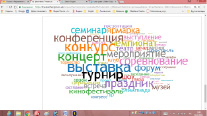
Picture 2.1. Similar words of one ancient root in different languages
We can make a conclusion, that each of the languages develops one of the aspects of the meaning of ancient roots.
2.1.2. Differences in semantics of words from the same ancient root within one language
Differences in the meaning of the ancient root can be found not only in different languages, but also within one of them.
Groups of English words with the same Latin roots are a good example. Some of them are presented in Appendix 12. I have studied the frequency of phrases for some pairs of English words coming from the same ancient root (Appendix 13). It can be concluded that the ancient root sets the general direction, and then the alive language transforms, expands and modifies its meaning in accordance with the epoch.
2.1.3. Differentiation by meanings in closely related languages
2.1.3.1. Similar ancient roots in related languages on the example of Slavic languages. Different languages reveal different nuances of meanings. Words often vary in their meaning over time [8]. It was very interesting for me to collect words formed from the same ancient root in related languages. In this section I paid special attention to Slavic languages, because they enable Russian-speaking people to catch the nuances of meaning in such words.
I have visited Slovenia, Czech Republic and Slovakia from among Slavic countries. In each of these countries, I took notes when I heard related ancient roots in everyday language. (Appendix 14). I have conducted a survey of native speakers in Slovenia and have analyzed the most interesting examples from the Slovenian language in the table (Appendix 15). Here are some of them: самолёт – letalo, огнетушитель – gasilnik, сувениры – spominki, закуски – prigrizki, семья – dru?ina, маяк – svetilnik, сумка – torbica, готовить – kuhati, ets. We see that the words are similar, but they seem to have a slightly different meaning.
2.1.3.2. The roots of the archaic and folklore Russian words in modern related languages. I have noticed that very often the words of other Slavic languages seem to us folklore and fairytale. The reason for this is in their affinity to archaic words of the Russian language. I have chosen some archaic Russian words, which are most often found only in folklore, and tried to find modern words with the same ancient roots in other Slavic languages with the help of dictionaries. Work in Sketch Engine enabled to show their meanings.
For example, you see how beautiful and fabulous this words sound for us:
• око (болг.), oko (чеш., хорв., словац.) – ОКО (глаз)
• пръстите (болг.), prsty (чешс., словац.), prsti (хорв.) – ПЕРСТЫ (пальцы)
• срам (болг.), sramota (хорв.) – СРАМОТА (стыд)
• kolo (словац.) – КОЛО (круг)
• живот (болг.), ?ivot (чешс., хорв., словац.) – ЖИВОТ (жизнь)
• otev?en? (чешс.), otvoreno (хорв.), otvorene (словац.) – ОТВОРЕНО (открыто)
• затворен (болг.), zatvoreno (хорв.), zatvorené (словац.) – ЗАТВОРЕНО (закрыто)
• лекар (белор.), лiкар (укр.) – ЛЕКАРЬ (врач)
• хора (болг.), lidem(чеш.), ljudi (хорв.), ?udí (словац.)– ХОР, ЛЮД (народ).
We understand how different the evolution of the ancient root can be in different languages. The word may become obsolete in one language, but continue to live in a related language. Such comparisons clearly show us the history and development of the words, and they help professionals to study the relationship of languages.
2.1.3.3. False friends of the translator. But not always similar words have alike meaning. Each nation and language can have its own logic of development, and over time the change of semantic meaning can lead to unexpected results. For example, in Czech «horky» means «hot», not «bitter», in Slovak and Slovenian «pozor» means «attention» [3]. I have collected such interesting examples from different Slavic languages in Appendix 16.
I have studied pairs of words with one ancient root with the help of Corpora of closely related languages (Appendix 17). I explored Slavic languages to make the results more evident and informative. Here are some vivid examples: the Russian word for «подорожник» in Belarusian sounds like «падарожжи», but is not a plant, but «companion» (Picture 2.2).
The word «гостинец» in Polish sounds like «go?ciniec» and means «highway, big road». Gradually, the Russian language has formed a logical chain: a guest-a gift-a delicious gift, and in Polish the logic is: a guest – from the road – a big road [7] (Picture 2.3).
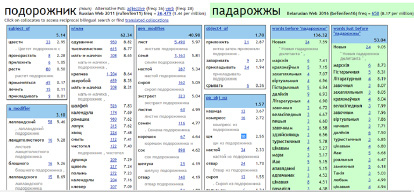
Picture 2.2. Studying of false friends of the translator (Russian and Belarusian Corpora)
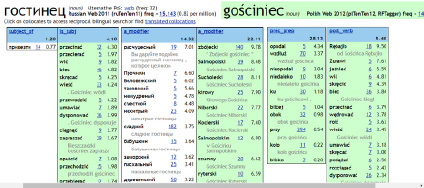
Picture 2.3. Studying of false friends of the translator (Russian and Polish Corpora)
The history of ancient roots is unique in each language. It is connected with traditions, culture, history of peoples and those roots pass from the past to the future.
2.2. The study of the influence of the language system on words of one ancient root
2.2.1. Comparison of words from one root in related languages of different systems
Cognate words enable us to compare the grammatical structure of languages. I have analyzed this phenomenon on the example of Russian and Bulgarian languages. Bulgarian is considered to be the only analytical among the Slavic languages, its grammar is quite different [3]. It has no case forms. Grammatical meaning is indicated not by changing the ending, but by using a preposition (Russian «капли росы», Bulgarian «капки от роса»).
It was interesting for me to select in Russian and Bulgarian the words that came from the same ancient roots and to see their behaviour in each of the languages. Thus, the transformations of cognate words give us an opportunity to see the difference in the structure of languages and to follow the trends of their development in time.
2.2.2. The study of changes in the structure of language in time by the example of words with ancient roots
Every alive language is changing its structure over time. The usage of words with ancient roots reflects these trends.
2.2.2.1. An example of study of changes in the Russian language using the NCRL (National Corpus of Russian Language). I have studied the time change in the use of the word «проблема» (coming from Ancient Greek root πρ?βλημα) by means of Russian National Corpus. This word has been used in Russian since 1558. But it turned out, that the word collocation «проблема с» appeared in our language only in the second part of the 20th century. The data curve from Russian National Corpus demonstrates it (Picture 2.4).
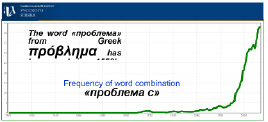
Picture 2.4. Data curve of frequency of word combination «проблема с»
The example of this word shows us the development of words with ancient roots in our modern language.
2.2.2.2. The movement of the English language towards analyticity, an example of analysis using the British National Corpus
I have analyzed the main trends in English related to its movement towards analyticity, the results are shown in Appendix 18. Linguists consider that the appearance of short-cut constructions in the language (easy-to-use, out-of-doors, all-too-good) also shows the movement of the language towards analyticity [1], [10]. With the help of the British National Corpus, I studied the frequency of use of short-cut constructions with ancient roots. Details of the study are shown in Appendix 19.
For example, the Diagram 2.1 demonstrates that «easy-to-use» is found only since the 70-s of the 20th century.

Diagram 2.1. Frequency of short-cut constructions per million words
In general it is possible to conclude that the frequency of use of these structures increases, thus with the help of the British National Corpus one of the examples of movement of English towards analyticity can be seen.
2.2.3. The description of language development by means of the Zaliznyak curve
The development of language may be represented as a sinusoid, called linguists «Zaliznyak curve» in honor of a famous academician Andrei Anatolyevich Zaliznyak [2]. Languages are very slowly moving along the curve up and down. While speaking, people often «erase» end morphemes. Little by little they disappear. Then we get a language with the simplest monomorphemic words. After that many service words appear in the language to express grammatical meanings. These service words little by little «get used» to their neighbors and become suffixes, prefixes, endings. I was interesting for me to try to place several languages on this curve. They move up or down at different speed (Picture II.5).
But it’s impossible to pinpoint the location of the language. For example, in English nouns already have no cases, and pronouns still have direct and indirect (he – him).
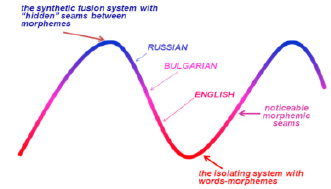
Picture 2.5. Zaliznyak curve
2.3. English as the lingua-franca of the modern world, analogy with Latin
I have analyzed the reasons for the widespread use of English in the modern world.
2.3.1. Analysis of the reasons for English to become the lingua-franca of our time
Historical and political reasons for the spread of the English language are:
1. The enormous historical influence of the colonial past of Great Britain.
2. The rapid development of the US economy, the growth of political influence of this country in the epoch of globalization.
Linguistic features of English, contributing to its transformation into the lingua-franca:
1. Rejection of complex phonetic laws and almost complete rejection of flexions [9].
2. A special feature of English is that it easily borrows words from other languages. This contributes to its enrichment and increases the ability to adapt.
3. A characteristic feature of English vocabulary is the ability of words to adapt to the epoch, changing their meaning.
Thus, linguistic features have contributed to the transformation of English into the language of world communication.
2.3.2. Trends in modern English as the lingua-franca
I have brought together the impact of wide spread of English on its development (Appendix 20).
1. The widespread use of English forms a tendency to separation.
2. Each of the branches of English in English-speaking countries has a huge impact on the language as a whole, changing its vocabulary and grammar rules.
3. Those who have studied English simplify the language.
4. Because of its prevalence, English is more influenced by the Internet modifications.
5. The movement towards analyticity, words become more isolated and the system of the language changes.
We may see that the development of the English language has its own features caused by its role as the language of international communication.
2.3.3. The analogy between English and Latin as the world languages of their epochs
The experience of mankind shows that in all times people would prefer to use natural, not artificial, languages to communicate between nations and countries [7]. This role was played by Latin at certain stages of development. Now English can be called the language of international communication. Languages of different structure turned to be similar in their role of the lingua-franca of their historical epochs. Therefore, if we want to understand the role of English and the future linguistic picture of the world as a whole, it is necessary to study the evolution of ancient languages.
Conclusions
• The conclusions of theoretical and practical studies
• Overall results:
• Languages incorporate ancient roots in their structure and develop the vocabulary on their basis.
• The evolution of ancient roots is unique in each language and depends on its history, traditions and structure.
• Ancient roots pass from the past to the future and define the affinity of languages.
• The identified trends enable to predict possible changes in the language picture of the world in the future.
Conclusion
The evolution of ancient roots in the language reflects its history and logic of development. There modifications show us the main trends in the language picture of the world.
The results of the study have confirmed the hypothesis.
Products on the base of the investigation
As a result of the project, educational games for adults and children of different ages have been developed (Appendix 21). Workshops at the Science Festival 2018 and in the primary school were held (Appendix 22).
Practical value of the project
1. The project is educational. It enables to look at languages from the historical point of view, and at the history of European civilization from the linguistic point of view.
2. The study demonstrates the capabilities of corpus linguistics as a unique tool for the analysis of linguistic phenomena.
3. Definition of trends in the development of languages can help computer linguistics.
4. Work on the project in English helps to improve the understanding of English scientific texts, to expand vocabulary and to get additional conversational practice.
Way forward
• The study of ancient roots in the Swadesh lists (the most stable basic vocabularies) of languages
• Study of phonetic changes in ancient roots in different languages
• Comparison of semantics of cognate words, their meanings in terms of the logic of languages and nations
• Creation of practical examples for the use of corpus linguistics in school education.
Библиографическая ссылка
Поспелова Т.А. DEEP ARE THE ROOTS… (THE DEVELOPMENT OF ANCIENT ROOTS IN EUROPEAN LANGUAGES) ИССЛЕДОВАНИЕ РАЗВИТИЯ ДРЕВНИХ КОРНЕЙ В ЕВРОПЕЙСКИХ ЯЗЫКАХ // Старт в науке. 2019. № 3-3. ;URL: https://science-start.ru/ru/article/view?id=1616 (дата обращения: 08.12.2025).
